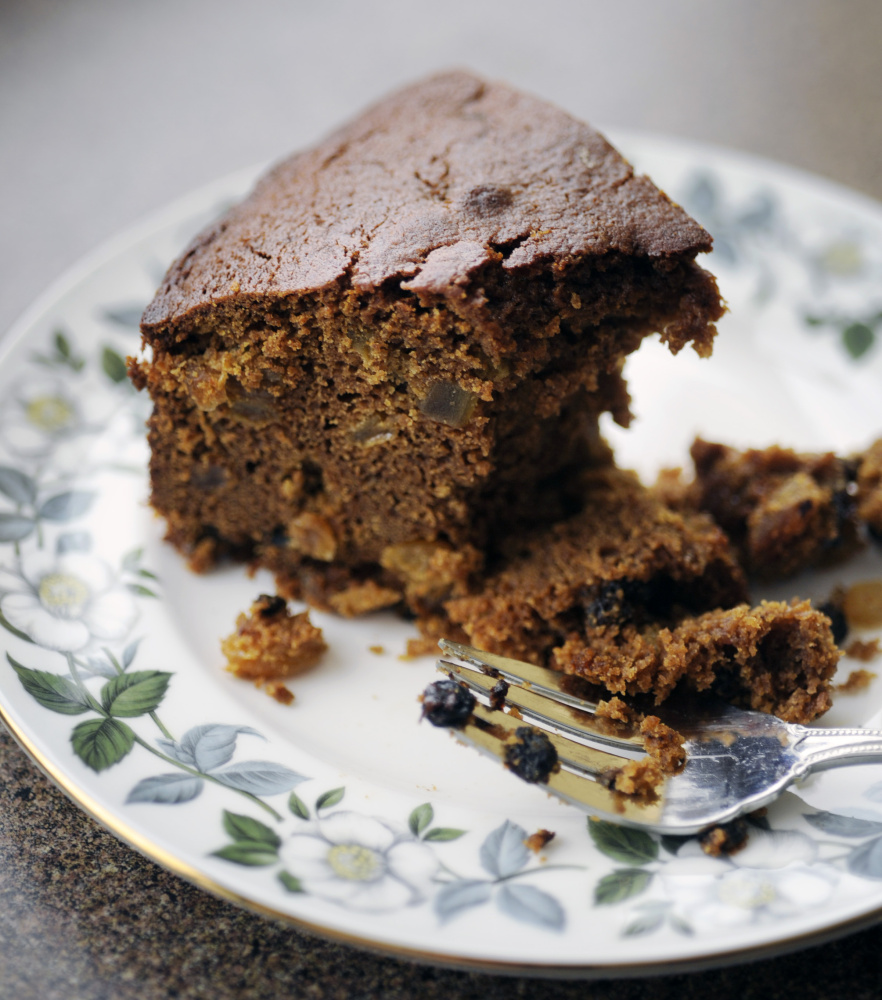As I grated and grated – and grated, I breathed in the pungent odor and marveled at how pretty whole nutmegs look inside. Bonus: It made my kitchen smell like Christmas.
But after 10 minutes, I’d had enough. I was glad go get down to the last little nub.
I had to grate an entire nutmeg, which turns out to be about 4 teaspoons, for a vintage recipe I was trying out at home. Reading old recipes always makes me want to get back in the kitchen and play 19th-century housewife, and it was no different after I spent a few hours with the Esta Kramer Collection of American Cookery at Bowdoin College.
I chose a circa 1877 recipe from Maine’s first published cookbook, “Fish, Flesh and Fowl: A Book of Recipes for Cooking Compiled By Ladies of State Street Parish.”
The recipe is for Sally Jewett Cake, presumably named for the second cousin of Maine author Sarah Orne Jewett. Sally Jewett (1820-1864) married her cousin Elisha, and they lived at 176 Portland St. in South Berwick. (Their house is still standing and is on the National Register of Historic Places.) The cookbook doesn’t say if this was Jewett’s own recipe or if it was just named after her.
Like most of the other recipes in the book, this recipe is merely a list of ingredients. There are no instructions on how to mix them together, what size pan to use or how long to bake the cake.
Here it is: “Three-quarters pound of sugar, one-half pound butter, one cup molasses, one cup milk, five eggs, one pound flour, heaping teaspoon of soda, one pound raisins, two teaspoons each clove and cinnamon, one nutmeg, currants, citron, wine glass brandy.”
That’s it.
A conversion chart helped me change pounds of sugar and flour to cups. I consulted with my editor about pan size. Should I use a regular cake pan? A bundt pan? Loaf pans? I knew this would be a big, dense cake, filled with a whole pound of raisins, which seems like a ridiculous amount. My editor wondered if the 19th-century raisins still had their seeds, which would have added to their weight. Or maybe raisins in 1877 were like chocolate in 2016 – people couldn’t get enough of them.
I went with a 10-inch springform pan, which turned out to be perfect. And I used all of the raisins called for, in order to remain true to the recipe.
For the method, I made some educated guesses: I blended together the first several ingredients, which were moist or soft, then mixed the dry ingredients together and added them, a little at a time, to the wet. I creamed together the sugar and butter by hand – there were no Kitchen Aid mixers in the 19th century – then added the molasses, milk and eggs. The batter looked like a brown slurry, not very appetizing. But once the dry ingredients went in, it came together well.
What to do with the brandy? I chose one of my smallest wine glasses – glasses were smaller in 1877 – and poured a glass full of brandy over the raisins, then soaked them overnight before making the cake, stirring occasionally. (I used golden raisins.) I added both the raisins and any unabsorbed brandy to the batter.
The recipe doesn’t say how many currants and how much citron to add, so I winged it, tossing in about a third to a half cup of each.
I placed the pan into an oven preheated to 350 degrees and set my kitchen timer for an hour. I’m guessing 19th century didn’t have kitchen timers either – or ovens with temperature controls and a light inside that makes it easy to check the progress of the cake. When I peeked in the oven an hour later, the edges of the cake looked good, but the center was still incredibly wet and jiggly. Fifteen minutes later, I looked again. Nope. Back into the oven for another half hour. Worried the edges would dry out, I turned the temperature down to 325 degrees and kept an eye on the cake.
After nearly two hours, the cake came out looking great – but it was heavy as a doorstop. Though the edges were brown and a little dry, when I sliced into it, the cake was moist, and the molasses and spices gave it a bold flavor. Tasters raved about it, and a co-worker who photographed a big slice brought me back an empty plate and a good suggestion: Cut back by, maybe, half a cup of raisins and add some nuts.
I would make this warm, comforting cake again, especially in winter. Sally Jewett, wherever you are, thank you.
Meredith Goad can be contacted at 791-6332 or at:
mgoad@pressherald.com
Twitter: MeredithGoad
Send questions/comments to the editors.




Comments are no longer available on this story